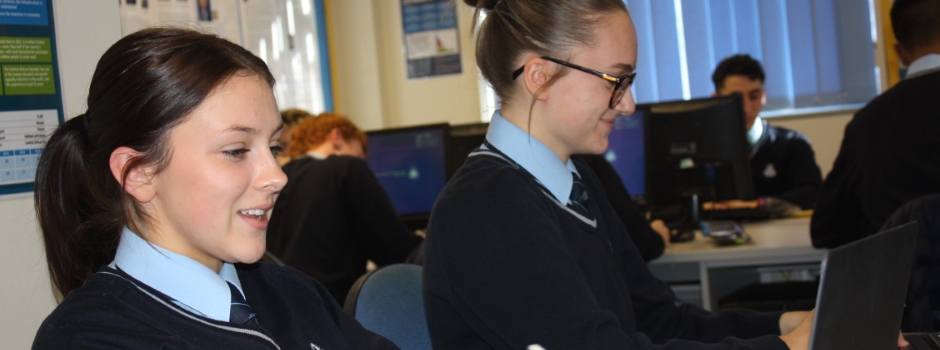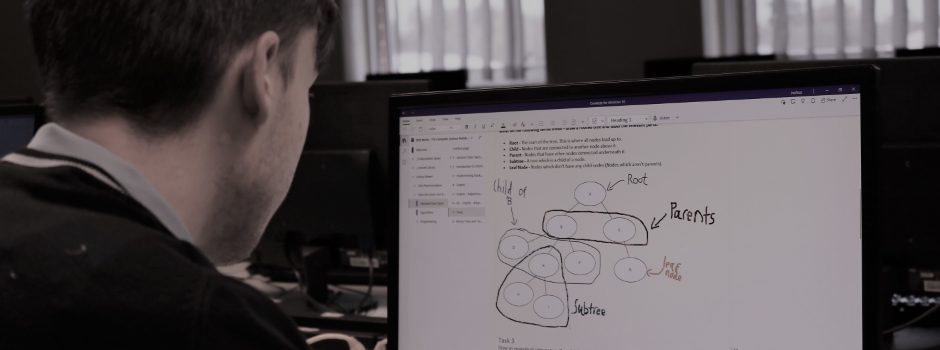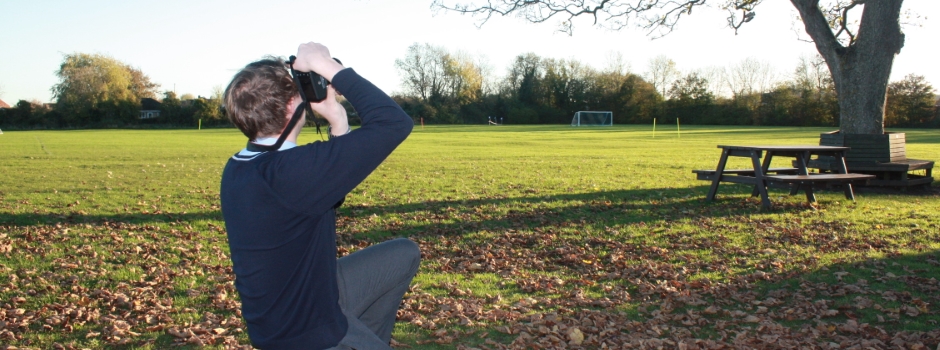



















































"I am unable to praise it enough or express how supportive and nurturing I have felt the entire staff to be."
Design & Technology Dept - Curriculum on a Page
Showing the curriculum by subject
Design Technology
Curriculum Details - 2023/2024 (Current)
| Year | Term 1 | Term 2 | Term 3 | Term 4 | Term 5 | Term 6 |
| 7 | Health and safety in the workshop and with tools - Craft Knife Motions and Linkages - Technical Knowledge Creating a storyboard - Investigate Rendering skills- adding shade and colour to give a realistic effect - Design | Paper mechanisms - Technical Knowledge - V-fold - sliders Creating a pirate pop-up book - Make Peer assessing and evaluating work - Evaluate | Introduction to woodworking tools. - bench hook - tenon saw Natural Timbers - hardwood - softwood - Technical knowledge Marking and measuring accurately - steel rule - Tri-square Making a wooden box - Making | Introduction to smoothing and shaping. - Linisher - sandpaper. Manmade timbers - manufactured boards. - Technical Knowledge Applying surface finishes to timbers. - Beeswax Evaluating practical work. - Evaluate | Introduction to workshop tools - the pillar drill. Different types of cams and their uses. - Technical knowledge | Introduction to 2D design - CAD skills. |
| 8 | Welcome to the Introduction to Health and Safety for the Speaker Project. This module aims to equip you with the necessary knowledge of electronic components, installation and soldering techniques, and the design cycle, which includes understanding the Design Brief and existing products. | We will be focusing on the construction of the outer casing for this project, which involves carrying out questionnaires, creating specifications, developing initial designs, constructing the casing, and evaluating the final product. | Introduction to Graphic Design Branding where we explore the principles of colour theory, typography, composition, tone, line, and imagery to create a captivating logo and brand products using sublimation printing. | To continue the manufacturing of the Branding material. Evaluation of the topic. | End of KS3 Topic - personal storage. To create a storage device that can be carried, using Timber, Polymer and Metal. Knowledge of material, manufacturing techniques and introduction to NEA. | We will continue with the production of the tea tray and assess the final product for quality. End of Key stage Assessment. |
DT: Graphics
Curriculum Details - 2023/2024 (Current)
| Year | Term 1 | Term 2 | Term 3 | Term 4 | Term 5 | Term 6 |
| 9 | Year 9 A of the exam paper 3.1.1 New and emerging technologies 3.1.1.1 Industry and people 3.1.1.2 Enterprise 3.1.1.3 Culture and society 3.1.1.4 Environment and sustainability 3.1.1.5 Production systems 3.1.1.6 Critical evaluation NEA Focus Section E | 3.1.2 Energy generation and storage 3.1.2.1 Fossil fuels and Nuclear power 3.1.2.2 Renewable sources of energy 3.1.2.3 Energy generation and storage Review Section 3.1.1 NEA Focus Mini NEA | 3.1.3 Developments in new materials 3.1.3.1 Modern materials 3.1.3.2 Smart materials 3.1.3.3 Composites 3.1.3.4 Technical textiles NEA Focus | 3.1.4 Systems approach to designing 3.1.5.Mechanical devices Review of 3.1.1 New and emerging technologies 3.1.2 Energy generation and storage 3.1.3 Developments in new materials NEA Focus | 3.1.6 Materials and their working properties 3.1.6 Paper and Board 3.1.6.2 Natural and manufactured timbers 3.1.6.3 Metals and alloys 3.1.6.4 Polymers 3.1.6.5 Textiles NEA Focus mini Same time as year 10 | Theory 3.1.6.2 Material properties Review of 3.1.4 Systems approach to designing 3.1.5 Mechanical devices 3.1.6 Materials and their working properties 3.1.6.2 Material properties NEA Focus |
| 10 | Year 10 we focus on section B of the exam paper Resistant materials group focuses on Timber Graphic Design Group focuses on Paper and Board 3.2.1 Selection of materials or components 3.2.2 Forces and stresses | 3.2.3.1 Social and ecological issues 3.2.3.2 The six R’s 3.2.4 Sources and origins 3.2.5.1 Properties of materials NEA | 3.2.5.3 Shaping and forming 3.2.6 Stock forms of materials 3.2.7 Scales of production NEA | 3.2.8.1 Tools, equipment and processes 3.2.8.2 Cutting to tolerance 3.2.8.3 Commercial processes 3.2.8.4 Quality control 3.2.9 Surface finishes and treatments Nea – Section A and C | 1st June official NEA Section A Analysing the three challenges Mind Map and Mood board Client Identified and interview 3.3.3.1 Past and present designers 3.3.3.2 Design companies Questionnaire 3.3.1.1 Investigation; primary and secondary | NEA Section A continued Designers Relevant Research Evaluation of Research Review against mark scheme Section B Design Brief Justified Specification Review against mark scheme 3.3.1.2 Writing a design brief and specification |
| 11 | Non-examined element; Writing of a specification. Generation of initial ideas. Review of initial ideas. 3.3.4.1 Generate imaginative ideas 3.3.5 Communication of design ideas 3.3.7 Selection of materials and components | Non-examined element; Development of design ideas into a chosen design. Review of chosen idea. 3.3.10 Specialist tools and equipment 3.3.11 Specialist techniques and processes 3.3.4.2 Explore and develop ideas 3.3.6 Prototype development 3.3.9 Material management HL Revision Mock | Section Completion of Section E Section F Evaluation of product Evaluation against specification Client feedback Submit coursework | Review coursework and ensure evidence is in place for all sections of the coursework. Revision for main exam | Revision for main exam assignments to be submitted onto teams leading up to the exam in June. | Revision for main exam assignments to be submitted onto teams leading up to the exam in June. |
DT: Product Design
Curriculum Details - 2023/2024 (Current)
| Year | Term 1 | Term 2 | Term 3 | Term 4 | Term 5 | Term 6 |
| 12 | Paper 1 L 01-Introduction-to-the-course Theory L 02-1.1 Materials and applications L 03 1.2 Materials and Applications Timber and manufactured boards L 05-6-1.2 Materials and applications Metals and alloys Mini NEA | Paper 1 L 07-8 1.2 Materials and applications Polymers L 09-10 1.2 Materials and applications Paper and Board L11 1.1 Materials and applications Composite materials Mini NEA | Paper 1 L12-13- 1.1 Materials and applications Smart and modern materials L14-1.1 Materials and applications Glass, ceramic and textiles L15-Testing Mini NEA | Paper 1 L16-Enhancement-of-materials L17-Wasting-processes L18-19-Redistribution L20-21-Fabrication NEA | Paper 1 L22-23-Finishes L24-25-Modern-scales-of-production L26-27-Digital-design-and-manufacture L28-30-Requirement-for-product-design NEA | Paper 1 L31-32-Health-and-safety L33-Protecting-designs L34-35-Design-for-manufacture L36-Feasibility-studies L37-38-Enterprise NEA SECTION C |
| 13 | Paper 2 - Continue to revise paper 1 L43-44-Design-methods L45-Design-history SECTION C | Paper 2 - Continue to revise paper 1 L46-47-Design-movements L48-Key-designers L49-51-Major-developments-in-technology L52-53-Design-processes | Paper 2 - Continue to revise paper 1 L54-55-Critical-analysis L54-55-Critical-analysis L56-selecting-tools-and-processes Mock | Paper 2 - Continue to revise paper 1 L57-Accuracy-in-design L58-59-Responsible-design L60-61-Design-for-manufacture L62-International-standards | Revision | Revision |
DT: Resistant Materials
Curriculum Details - 2023/2024 (Current)
| Year | Term 1 | Term 2 | Term 3 | Term 4 | Term 5 | Term 6 |
| 9 | Year 9 A of the exam paper 3.1.1 New and emerging technologies 3.1.1.1 Industry and people 3.1.1.2 Enterprise 3.1.1.3 Culture and society 3.1.1.4 Environment and sustainability 3.1.1.5 Production systems 3.1.1.6 Critical evaluation NEA Focus Section E Practical skills – joinery | 3.1.2 Energy generation and storage 3.1.2.1 Fossil fuels and Nuclear power 3.1.2.2 Renewable sources of energy 3.1.2.3 Energy generation and storage Review Section 3.1.1 NEA Focus Mini NEA Wooden Caddy Storage of personal possessions | 3.1.3 Developments in new materials 3.1.3.1 Modern materials 3.1.3.2 Smart materials 3.1.3.3 Composites 3.1.3.4 Technical textiles NEA Focus Mini NEA Wooden Caddy – Storage of personal possessions | 3.1.4 Systems approach to designing 3.1.5.Mechanical devices Review of 3.1.1 New and emerging technologies 3.1.2 Energy generation and storage 3.1.3 Developments in new materials NEA Focus | 3.1.6 Materials and their working properties 3.1.6 Paper and Board 3.1.6.2 Natural and manufactured timbers 3.1.6.3 Metals and alloys 3.1.6.4 Polymers 3.1.6.5 Textiles NEA Focus mini Same time as year 10 | Theory 3.1.6.2 Material properties Review of 3.1.4 Systems approach to designing 3.1.5 Mechanical devices 3.1.6 Materials and their working properties 3.1.6.2 Material properties NEA Focus |
| 10 | Year 10 we focus on section B of the exam paper Resistant materials group focuses on Timber Graphic Design Group focuses on Paper and Board 3.2.1 Selection of materials or components - Timber and wood 3.2.2 Forces and stresses - Timber and wood | 3.2.3.1 Social and ecological issues 3.2.3.2 The six R’s 3.2.4 Sources and origins 3.2.5.1 Properties of materials NEA | 3.2.5.3 Shaping and forming 3.2.6 Stock forms of materials 3.2.7 Scales of production NEA | 3.2.8.1 Tools, equipment and processes 3.2.8.2 Cutting to tolerance 3.2.8.3 Commercial processes 3.2.8.4 Quality control 3.2.9 Surface finishes and treatments Nea – Section A and C | 1st June official NEA Section A Analysing the three challenges Mind Map and Mood board Client Identified and interview 3.3.3.1 Past and present designers 3.3.3.2 Design companies Questionnaire 3.3.1.1 Investigation; primary and secondary | NEA Section A continued Designers Relevant Research Evaluation of Research Review against mark scheme Section B Design Brief Justified Specification Review against mark scheme 3.3.1.2 Writing a design brief and specification |
| 11 | Non-examined element; Writing of a specification. Generation of initial ideas. Review of initial ideas. 3.3.4.1 Generate imaginative ideas 3.3.5 Communication of design ideas 3.3.7 Selection of materials and components | Non-examined element; Development of design ideas into a chosen design. Review of chosen idea. 3.3.10 Specialist tools and equipment 3.3.11 Specialist techniques and processes 3.3.4.2 Explore and develop ideas 3.3.6 Prototype development 3.3.9 Material management HL Revision Mock | Section Completion of Section E Section F Evaluation of product Evaluation against specification Client feedback Submit coursework | Review coursework and ensure evidence is in place for all sections of the coursework. Revision for main exam | Revision for main exam assignments to be submitted onto teams leading up to the exam in June. | Revision |